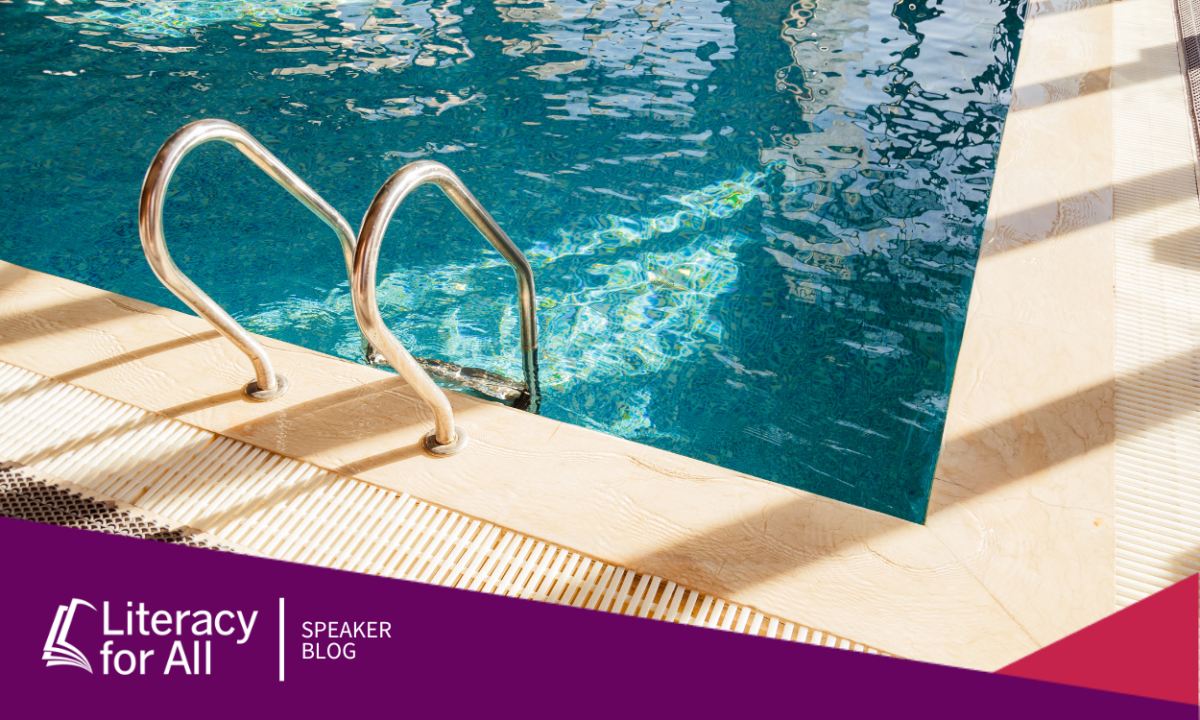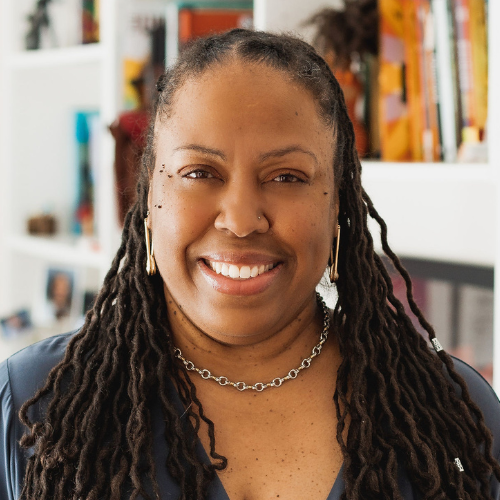These long, hot summer days for many people are filled with fun and leisure, time off from work and school, vacations, days at the beach, ice cream, cookouts, camp and camping, and going swimming. Be it in your own backyard, a neighbor’s, or a community pool, above-ground or in-ground, there are few things more refreshing and fun on a hot day than jumping, diving, and wading into cool pool waters.
There was a time in the United States, however, when public pools were segregated by race. When they were integrated in the mid-1950s, not everyone was pleased with this change. Some responded violently, forming mobs to intimidate, threaten and harm those who would dare exercise their right to enjoy community pools. Some towns even poured tar into the pools rather than integrate them, denying everyone access. Heather McGhee explores this topic in The Sum of Us. Deborah Miles depicts in the Freedom Summer picture book.
Many of us would like to think that these times are behind us in the United States, but the same thing is happening again. Instead of closing pools, there are people who are proposing and enacting legislation that denies children the opportunity to learn about one another through the windows offered in books. According to an ABC News article published in March 2022, anti-truth legislation that would restrict education on race in classrooms has been introduced (21 states), signed into law (16 states), or attempted but failed to pass (6 states). This represents 86% of the United States. Only California, Connecticut, Delaware, Oregon, Massachusetts, Nevada, and Vermont had not attempted to pass such legislation at the time the article was written.
Those who support this legislation claim that it’s to keep White children from being made to feel guilty for being White, to keep children from experiencing discomfort, and to protect them from being indoctrinated against the United States and their parent’s values. Let’s take a look at each of these concerns:
Feeling Guilty for Being White
When a teacher engages students with culturally responsive, antiracist, pro-human instructional practices and content effectively, the outcome for students is not guilt. Learning to explore, examine, and question aligns with any child’s natural curiosity and wonder, and provides students with the skills they need to engage as informed citizens in a democratic society. Although there are challenging and troubling things to learn about colonization and enslavement in the history of the United States, and the current impact on our society, there are also abolitionists, freedom riders, and civil rights activists for students to choose to identify with as changemakers. It is my hope that anyone who loves a child in their lives would want them to have this opportunity.
Eliminating Discomfort
If we’re honest with ourselves, we will admit that learning about hard things can involve some discomfort. It can be challenging to explain to a child, for example, that some people are sleeping on the street because they are experiencing homelessness. It is sad that some people don’t have homes. Hopefully, though, when a child learns that something sad has happened or is happening, they will learn what it means to care and to act. What kind of world are we creating by denying students opportunities to develop empathy and to see themselves as upstanders and those who can work in solidarity with one another to make sure that everyone is treated fairly?
Avoiding Indoctrination
Indoctrination is defined as the process of teaching a person or group to accept a set of beliefs uncritically. Many of the books being challenged in schools and libraries, in addition to exploring the impact of racialization in the United States, and celebrating those who worked to end racial oppression, feature the stories of Black and Brown people doing ordinary things. They are about fathers learning to do their daughter’s hair, a boy’s trip to a barber shop, and a child who thinks the moon is following him. They are about learning to love yourself, cooking with a grandparent, and learning to swim. In 2020, an infographic published by the Cooperative Children’s Book Center showed that 41% of the characters featured in children’s books were White, 12% were Black, 9% were Asian, and 6% were Latin/a/o/x, while 29% were about animals, which is 2% higher than the representation of all other groups of People of Color combined (there was only 0.001% Pacific Islander, 0.008% Arab, and 0.15% Indigenous character representation). I contend that the true indoctrination, especially in light of how few books are actually about children of color, is attempting to keep students from accessing content that humanizes all people and teaches students to think critically.
No true educator would knowingly cause students to feel guilty or uncomfortable, or try to get them to accept something as true without analysis and evaluation. To do so would not only be in opposition to what we know about how the brain learns and the importance of psychological safety in the learning process, it would be the equivalent of educational malpractice. Even with this knowledge, being accused of doing harm to children is upsetting and hurtful. I believe we are seeing the impact of these accusations exacerbated by years of insufficient teacher support in the number of open teaching positions across the country.
Here’s what can help as you navigate these challenges:
- Engage in your own racial healing work. These accusations can sting with a particular intensity when we have not participated in our own racial awareness journeys. This journey will help us to discover how we’ve been racialized, the historical and current impact of racialization, and will equip us to respond effectively and strategically to the resistance we’re facing. I highly recommend Anneliese Singh’s Racial Healing Handbook, Resmaa Menakem’s My Grandmother’s Hands, and Ibram Kendi’s How to Raise an Antiracist as great first steps toward racial healing.
- Don’t engage in this work alone, and don’t reinvent the wheel. Find a community of educators where you can both receive and give support as you engage in the essential work of developing antiracist and pro-human instructional practices. Organizations like Building Antiracist White Educators (BARWE), Embracing Equity, Showing Up for Racial Justice (SURJ), Teaching While White, The Equity Literacy Institute, and The Racial Equity Institute (REI) can be particularly helpful. Additionally, organizations like Facing History and Ourselves, Learning for Justice, The Strategic Education Research Partnership, and The Zinn Education Project offer supportive instructional resources at no cost.
- Be willing to make mistakes. Our students need to see us engaging in productive struggle and grappling with the cognitive dissonance that can come along with shifting our instructional practices to reflect an antiracist, pro-human mindset. It can be scary to make mistakes, especially because our work is under so much fear-based scrutiny. When we push through that fear, however, and embody what a growth mindset looks like, we can develop the trust needed in our relationships with students to truly help them become the leaders and changemakers they can be.
In Eloquent Rage, Brittney Cooper states that “[c]uriosity is often the first casualty of the politics of fear. Sometimes the things we fear most are our questions. More specifically, we fear the questions to which we don’t have answers. When we are afraid, we stop asking questions and start seeking short-term solutions. The work of my hands is the work of teaching students how to ask more and better questions. It is the work of rescuing curiosity from the clutches of fear.”
What will you say to your children when they ask how you responded when fear-filled people passed laws to try to keep them from learning about people who may differ from them? Did you speak up? Were you silent? Going back to the pool analogy, if we don’t offer them a satisfying answer, children will find someplace else to swim – a place where they can splash, laugh, and enjoy playing with other swimmers, where the uninterrupted invitation to enjoyment is given to all, without the distracting burden of exclusion. They will do this because it is natural for people to free themselves from things that constrict and smother. The beauty of difference is compelling and expansive, as the natural world shows us. The children are watching. Show them something beautiful.

About the Author:
Afrika Afeni Mills is an Education Consultant and the author of Open Windows, Open Minds: Developing Antiracist, Pro-Human Students. She works with teachers, coaches, and administrators to develop and sustain student-centered learning experiences that are diverse, inclusive, and equitable. Afrika has been featured on podcasts, blogs, delivered keynote addresses, and facilitated sessions at conferences across the United States. Afrika believes that all educators can be motivated, engaged, dynamic practitioners and leaders when provided with the support needed to create student-centered, anti-bias, anti-racist, culturally responsive learning environments that inspire wonder and creativity and nurture diversity, belonging, equity, and inclusion.





